PREVIOUS
Netaji Subhas Chandra Bose - II
July 6 , 2019
2115 days
16279
0
Back to East
- He took a risky journey back east and reached Japan where he assumed command over 40,000 soldiers recruited from Singapore and other southeast Asian regions.
- He called his army the ‘Indian National Army’ (INA) and led the same to capture the Andaman and Nicobar Islands from the British and rechristened it as Shaheed and Swaraj Islands.
- Japanese took possession of Andaman and Nicobar Islands in 1942.
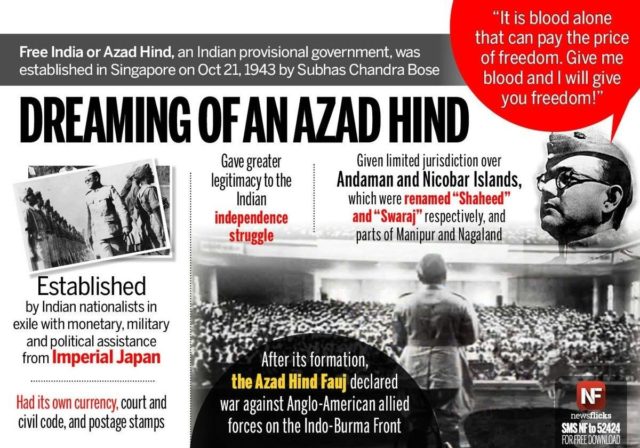
- The Provisional Government and the INA were established in the Andaman and Nicobar Islands with Lt Col. A.D. Loganathan appointed its Governor-General.
- A provisional “Azad Hind Government” started functioning in the captured territories on the 21st of October 1943.
- The Azad Hind Government has produced its own currency, postage stamps, court, and civil code, and was recognized by nine Axis states.
- This government participated in the so-called Greater East Asia Conference as an observer in November 1943.
- Unfortunately, the tide of the World War turned and the Japanese and German forces surrendered which forced him to call off further advancement.
- In February 1943, after being disillusioned that Germany could be of any help in gaining India's independence, he left for Japan.
- He traveled with the German submarine U-180 around the Cape of Good Hope to the southeast of Madagascar.

- There he was transferred to the I-29 for the rest of the journey to Imperial Japan.
- This was the only civilian transfer between two submarines of two different navies in World War II.
- He landed in Japanese-held Sumatra in May 1943.
- Thus, he took a risky journey back east and reached Japan.
- There he met Rash Behari Bose in July 1943, who handed over the command of the Indian National Army (INA) and the political organization of Indian Independence League to Bose.
- Thus, he assumed the command of the INA which merged the Indian Independence league with it.
- Earlier, Japanese took the possession of Andaman and Nicobar Islands in 1942.
- A provisional “Azad Hind Government” or Provisional Government of Free India started functioning in Singapore (Captured territories by Japanese) on the 21st of October 1943.
- It consisted of a Cabinet headed by Subhas Chandra Bose as the Head of the State, The Prime Minister and the Minister for War and Foreign Affairs.
- The Azad Hind Government has produced its own currency, postage stamps, court and civil code, and was recognised by nine Axis states.
- This government participated in the so-called Greater East Asia Conference as an observer in November 1943.
- The Provisional Government and the INA were established in the Andaman and Nicobar Islands also with Lt Col. A.D. Loganathan as its Governor General.
- He visited the Andaman Islands and recommended to rechristen it as Shaheed and Swaraj Islands on December 30, 1943.
- On 30th December 1943, Netaji Subhash Chandra Bose hoisted the National Flag for the first time at the Gymkhana Ground (present Netaji Stadium) in Port Blair of Andaman Islands.
- He also announced the Andaman Islands, the first Indian Territory freed from the British rule.
- Unfortunately, the tide of the World War turned and the Japanese and German forces surrendered which forced Bose to call off further advancement.
Formation of the INA
- The Indian National Army was the brainchild of Japanese Major Iwaichi Fujiwara.
- After the initial proposal by Fujiwara, the Indian National Army was formed as a result of discussion between Fujiwara and Mohan Singh in the second half of December 1941.
- Over 40,000 soldiers were recruited from Singapore and other south East Asian regions.
- The name was chosen jointly by them in the first week of January 1942.
- The first INA was however disbanded in December 1942 after disagreements between the Hikari Kikan and Mohan Singh.
- The idea of an independent army was revived with the arrival of Subhas Chandra Bose in the Far East in 1943.
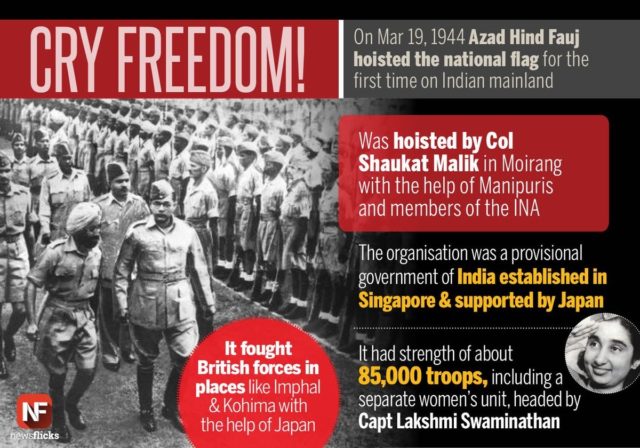
- INA had a separate women's unit, the Rani of Jhansi Regiment headed by Capt. Lakshmi Swaminathan, which is seen as a first of its kind in Asia.
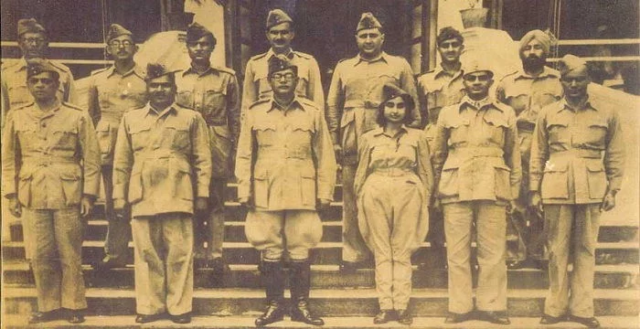
- The INA started for India and crossed Burma Border, and stood on Indian soil on March 18, 1944.
- On 6 July 1944, in a speech broadcast by the Azad Hind Radio from Singapore, Bose addressed Gandhi as the "Father of the Nation" and asked for his blessings and good wishes for the war he was fighting.
- This was the first time that Gandhi was referred to by this appellation.
- INA used the slogan Inquilab Zindabad, which was coined by Maulana Hasrat Mohani.
Ideology
- On February1922, Bose express his view after the unilateral withdrawal of the Non-cooperation movement by Gandhi via 1922 bardoli resolution, that “To sound the order of retreat just when public enthusiasm was reaching the boiling point was nothing short of a national calamity".
- Bose advocated complete unconditional independence for India, whereas the All-India Congress Committee wanted it in phases, through Dominion status.
- Finally, at the historic Lahore Congress convention, the Congress adopted Purna Swaraj (complete independence) as its motto on 19 December 1929.
- Also, Bose opposed withdrawal of Civil Disobedience Movement in 1934.
- In 1940s, Gandhi had all sympathy for Britain for World war II and had distinction between democratic Europe and fascism.
- So, Gandhi don’t want to make trouble during the war period.
- But Bose’s stance did not change with the outbreak of the War, he saw as an opportunity to take advantage of British weakness.
- Bose believed that Gandhi's tactics of non-violence would never be sufficient to secure India's independence, and advocated violent resistance.
- Subhas who called himself a socialist, believed that socialism in India owed its origins to Swami Vivekananda.
- In 1944, Bose similarly stated, "Our philosophy should be a synthesis between National Socialism and communism.
- His most famous quote was "Give me blood and I will give you freedom", which was said by him on July 4th, 1944 at a rally of Indians in Burma.
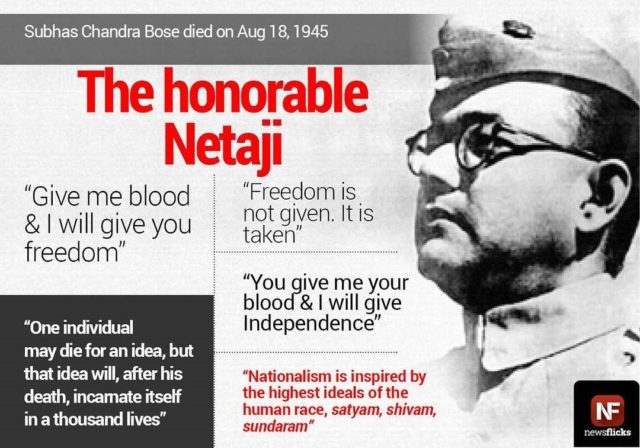
- Another famous quote was Dilli Chalo ("On to Delhi)!". This was the call he used to give the INA armies to motivate them in the Indian Campaign at the North East.
- Jai Hind, or, "Glory to India!" was another slogan used by him and later adopted by the Government of India and the Indian Armed Forces.
- Another slogan coined by him was "Ittehad, Etemad, Qurbani" (Urdu for "Unity, Agreement, Sacrifice").
Published works
- The Indian Struggle, 1920-1934
- Other works, unpublished in his lifetime, can be found in the Collected Works published by the Netaji Research Bureau.
Last Stage
- In the consensus of scholarly opinion, Subhas Chandra Bose's death occurred on 18 August 1945 after his overloaded Japanese plane crashed in Taiwan.
- The Shah Nawaz Committee (1956) and Khosla Commission (1970) and the Mukherjee Commission (1999) were appointed to investigate his mysteries death by Indian government.
Legacy
- The honorific title of “Netaji” was first applied in early 1942 to Bose in Germany by the Indian soldiers of the Indian Legion, German and Indian officials in the Special Bureau for India in Berlin.
- It was later used throughout India.
- Bose was featured on the stamps in India from 1964, 1993, 1997, 2001, 2016 and 2018.
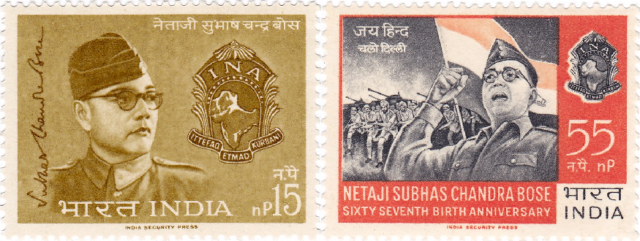
- Kolkata’s Airport was named as ‘Netaji Subhas Chandra Bose International Airport’.
- Recently, the Prime Minister of India renamed three of the Andaman Islands.
- Ross Island was renamed as ‘Netaji Subhash Chandra Bose Dweep’ and the Neil Island as Shaheed Dweep; and the Havelock Island as Swaraj Dweep.
- - - - - - - - - - - - - -
Leave a Reply
Your Comment is awaiting moderation.


